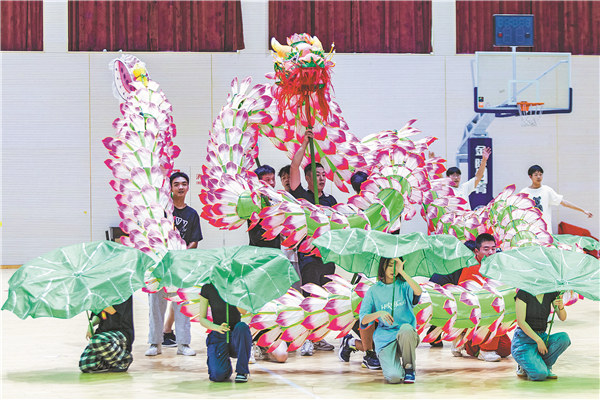

From delicate designs to dragon dancing, Zhejiang province shows its colorful heritage, Xu Haoyu reports.
To further promote the integration of traditional intangible cultural heritage into modern life, on the eve of, and throughout, the Asian Games, organizations from various regions have engaged in the study and presentation of traditional culture.
Last month, students from Hangzhou Vocational and Technical College visited Xiangshan county in Ningbo, Zhejiang province, to learn about the local intangible cultural heritage together with villagers. Their visit saw them witness firsthand woodblock printing techniques and Fuyang oilpaper umbrella craftsmanship, among other skills.
One particular aspect of Zhejiang culture, Baiyelong dance, made an immediate impression on hundreds of millions of TV viewers at the Asian Games' opening ceremony.
Back in July, the Changxing Baiyelong dance troupe was informed that Baiyelong dance had been selected as a warm-up performance for the ceremony. Baiyelong, which literally means "a dragon made of 100 lotus leaves", was inspired by a local legend about a dragon born in a lotus pond. During approximately two months of rehearsals, the troupe continuously refined the program to set higher requirements for everyone's positioning synchronization and connection.
Zhejiang's culture is rooted in both intricacy and vitality. Take for example the assembly process of the oilpaper umbrella's frame.
Connecting the umbrella ribs, handle and top requires processes such as splicing and threading. These steps, which seemed incredibly easy in the hands of Wen Shishan, a representative inheritor of the Zhejiang provincial-level intangible cultural heritage technique, are actually quite challenging for beginners.
Each step requires the utmost patience and attention to detail.
Although the process was tough and time-consuming, the sense of excitement was palpable among both villagers and students when they saw the beautiful oilpaper umbrellas gradually coming together in their own hands.
Through this umbrella-making experience, people gained a deeper and more genuine appreciation for the dedication and perseverance embodied in the craftsman's spirit.
Lincheng town in Huzhou city, Zhejiang, has also brought intangible cultural heritage, such as the Baiyelong dance, lion dance, Longshan dry boat and paired wrestling to villages.
"As the Asian Games start, we are organizing a variety of practices and activities to showcase the beautiful life, civilized customs and cultural charm of Lincheng," says Bai Lin, an official of Lincheng town. "Through these activities, we aim to subtly guide everyone to understand the Games and present our culture, thus contributing to the welcoming of the Asian Games.
"Next, we will continue to mobilize people to foster a strong atmosphere of love, support and participation in the Asian Games, showcasing cultural confidence, conveying the warmth of Lincheng and, together, add more color to the Asian Games!"
In addition to intangible cultural heritage experiences and learning activities organized spontaneously by the public, some specific performances are being showcased during the Asian Games and the Baiyelong dance is a highlight.
This traditional folk custom activity in Changxing county in Huzhou was selected as a provincial-level intangible cultural heritage in May 2005.
Unlike the props used in traditional Chinese dragon dances, which are normally covered by cloth of gold and red, the body in the Baiyelong dance is composed of hundreds of pink lotus petals.